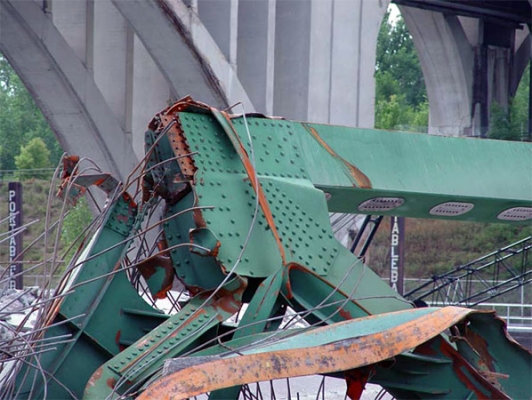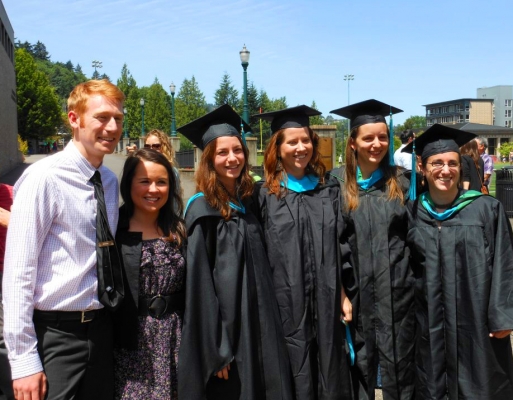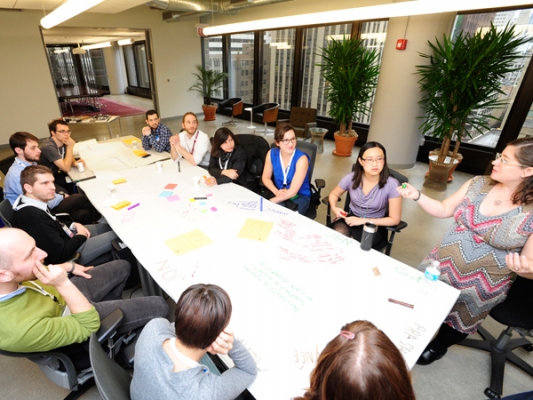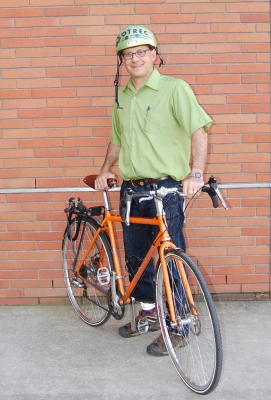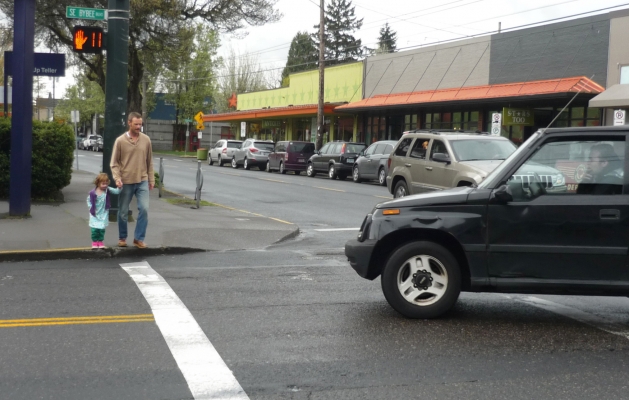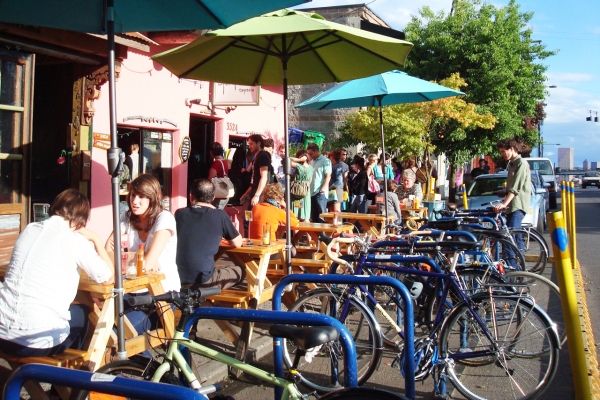Five OTREC-supported student transportation researchers presented their work Wednesday at Portland State University's first Student Reserach Symposium. Tara Goddard and Katherine Bell presented their work in panel sessions, while Sam Thompson, Patrick Singleton and Oliver Smith presented posters.
Goddard presented her paper, "Are Bicycling and Walking 'Cool'?: Adolescent Attitutes About Active Travel," in the public health and urban studies session. She'll offer an in-depth take on the same topic at noon May 24 for OTREC's Friday transportation seminar. Click here for more information.
Bell's paper, "Evaluation of Smart Phone Weight-Mile Truck Data for Supporting Freight Modeling, Performance Measures and Planning," details some of her work with civil engineering associate professor Miguel Figliozzi. Click here to download a version of the paper.
Thompson's poster was "A Study of Bicycle-Signal Compliance Employing Video Footage;" Singleton's poster was "A Theory of Travel Decision-Making: Applications for Active Travel;" Smith's was "The Effects of Mode Choice on Subjective Well-Being: Evidence from Portland, Oregon."
The...
Read moreAn OTREC research project recently took a look at gusset plate connections, the riveted plates of sheet metal that hold steel truss bridges together.
These connective plates have come to the attention of the Federal Highway Administration (FHWA), because in 2007 the collapse of the Interstate-35W Bridge in Minneapolis was the result of a failed gusset plate.
After the collapse, which killed 13 people and injured 145, the FHWA issued a set of guidelines for load rating — or determining the weight-bearing capacity — of gusset plates.
Historically, only bridge truss members were considered for load rating during safety inspections. Gusset plates were thought to be reliable based on conservative assumptions employed during their design.
For more details, visit the project page.
Roughly 20,000 steel bridges in the United States are classified as non-load-path-redundant, or fracture critical, bridges. This means that the failure of a single truss member or connection could lead to collapse.
The problem, says the project's lead investigator Christopher Higgins, happens when a plate goes out of plane. It’s supposed to be perfectly flat, but with too much load put on it, it can develop a bifurcation and go from stable to unstable.
“It’s...
Read moreA new transportation class at the University of Oregon, launched in January 2013 and funded by grants from OTREC and NITC, by all accounts had a wonderful first term.
Conceived as part of the curriculum for the Oregon Leadership in Sustainability (OLIS) program at U of O, the course, titled Sustainable Transportation, will be a permanent part of the OLIS class roster and will be open to all graduate students at the university.
The class this winter, led by instructors Ann Scheerer and Larisa Varela, taught applied research in a real-world setting. Students worked on planning projects for the university and for its home community, the City of Eugene, Ore.
On March 20, 2013, U of O's Transportation and Livability Student Group, LiveMove, hosted a public event where students were invited to present their research and interested community members were invited to attend.
The day of the presentations in Eugene was exciting; the “icing on the cake” for Scheerer. Marc Schlossberg, OTREC/NITC executive committee member at U of O and faculty advisor for LiveMove, was there, and so were some professors from the planning department, staff from the sustainability office, and quite a few local transportation advocates.
Scheerer, a...
Read moreSix graduate students from the Master of Urban and Regional Planning program at Portland State University have been awarded a national prize by the American Planning Association.
The research team, working under the name Celilo Planning Studio, won the 2013 APA student award for Application of the Planning Process.
Team members Danielle Fuchs, Michael Ahillen, Ellen Dorsey, Chloe Ritter, Sara Morrissey and Sarah Bronstein were honored for excellence in the way they carried out their project plan.
Ritter, Morrissey and Bronstein accepted the award on behalf of the group at the APA national conference this month in Chicago.
“We were very excited to attend APA and receive the award,” said Morrissey, the team’s communications director. “The conference is great to learn about what other cities are working on and get a feel of what’s going on.”
Morrissey and other members of the planning team have OTREC connections. She and Chloe Ritter worked with PSU professor Kelly Clifton on a consumer spending project, with a focus on cyclists and pedestrians. Sarah Bronstein has also worked on...
Read moreThe American Planning Assocation held its annual conference in Chicago this April.
Two OTREC universities sent students to attend, and OTREC staff member Jon Makler attended the Intelligent Cities "Unconference," which was held on Wednesday, April 17.
In addition to Portland State University graduate student research group Celillo Planning Studio, which won the APA student award for Application of the Planning Process, there were other PSU students who attended just to soak up the conference. Two students from the University of Oregon also attended and created a research poster for the conference.
This year's APA gave some focus to transportation. In addition to Monday, April 15 being themed "Transportation Day: Transforming Cities Through Transportation," there were also a handful of other transportation events including workshops titled "Sustainability Implications for Urban Transportation" and "Transportation Planning in a Changing Climate."
Makler, OTREC’s Education and Technology Transfer Program Manager, said that one of this year's highlights for him was the Unconference: a facilitated, participant-driven meeting which encouraged attendees to explore the ideas they were most interested in talking about. OTREC was one of about 25 organizations to take part in the Unconference.
...
Read moreThe quality of OTREC research has recently been recognized on a national level.
Selected data from the Portland Oregon Regional Transportation Archive Listing (PORTAL) will be part of a new national data sharing platform.
The US Department of Transportation has released the first version of this platform, called the Research Data Exchange, which collects and publishes archived and real-time transportation data from multiple sources.
In the language of their home page, the Research Data Exchange (called the RDE for short) was primarily developed to “support the development, testing, and demonstration of multi-modal transportation mobility applications being pursued under the USDOT ITS Dynamic Mobility Applications (DMA) Program and other connected vehicle research activities.”
In other words, USDOT created this database so they could use it. But – in the spirit of collaboration common to those with an interest in collecting and managing vast amounts of information – they’re sharing it.
The RDE is free and open to the public. Registered users...
Read moreOTREC research associate John MacArthur, in partnership with Drive Oregon, has been awarded a grant from Metro.
The grant is part of a $2.1 million effort by Metro to improve air quality and community health.
With the Metro grant, Drive Oregon and MacArthur plan to conduct a study of consumer perception and use of electric bicycles, pedal-bikes that provide extra propulsion from a rechargeable battery.
The idea is to see whether having the use of an e-bike will persuade non-bicycle-commuters to use a bike for the “first and last mile” of their daily commute; for example, to get from their workplace to the nearest MAX light rail station.
The e-bikes provided in the study will be foldable for convenient carrying onto the train. Ultimately, the partners of this study hope to increase the percentage of people who commute by bicycle and light rail, thus contributing to overall community health by reducing automobile emissions.
30 e-bikes will be loaned to 180 employees of Kaiser Permanente, at three designated work locations. Each participant will have the free use of an e-bike for one month, bookended by surveys about their expectations and perceptions of the experience.
MacArthur is conducting some overlapping research into e-bike use in a...
Read moreFlashing-yellow-arrow traffic signals offer convenience for drivers by permitting them to turn left after yielding to oncoming traffic. This convenience, OTREC research has found, can come at the expense of safety, especially where the traffic mix includes pedestrians.
OTREC researchers David Hurwitz of Oregon State University and Christopher Monsere of Portland State University examined how driver behaviors affect pedestrian safety at flashing yellow arrows. Their findings show that drivers at these intersections often don’t even look for pedestrians.
This research will be the focus of OTREC’s first live interview-style Webinar May 7. Host Steph Routh of Oregon Walks will interview the researcher-practitioner team, explore real-world applications and take audience questions. The Webinar is free. Details are at this link:
Flashing yellow arrows have been replacing other left-turn signals, such as solid green or flashing yellow or red circles, to indicate that drivers may turn after yielding to oncoming traffic. These turns are considered “permissive.” Turns where no conflicting traffic is present, such as those indicated with a green arrow, are “protected” turns. The flashing yellow arrow’s inclusion in the 2009 Manual on Uniform Traffic Control Devices sped up the signal’s adoption to...
Read moreBicycle commuters represent a significant chunk of business consumers in Portland, Ore., one of America's most bike-friendly cities. OTREC research in the past year has provided data on how cyclists and other mode users patronize local businesses.
During Hurricanes Ivan in 2004 and Katrina in 2005, at least 11 highway and railroad bridges along the U.S. Gulf Coast were damaged. When the water rose during the storms, wave forces slammed into the bridges’ supporting substructures, and when it rose high enough, the water’s buoyancy had enough power to lift off sections of a bridge’s superstructure and lay them aside like giant Legos.
To build bridges that can withstand the force of hurricane waves, engineers must be able to estimate the effects those waves will have on bridge structures. An OTREC project led by Oregon State University professor Daniel Cox examined the effects of wave loading on highway bridge superstructures.
Cox and co-investigator Solomon C. Yim, also of Oregon State University, conducted experiments in the Large Wave Flume at the O.H. Hinsdale Wave Research Laboratory at Oregon State University. They used a 1:5 scale, reinforced concrete model of a section of the Interstate 10 Bridge over Escambia Bay, Fla, which failed during Hurricane Ivan.
To see more details about the project, “Hurricane Wave Forces on Highway Bridge Superstructure,” click here, or download the final report.
The...
Read more
